01. The New World
¶ 1
Leave a comment on paragraph 1 1
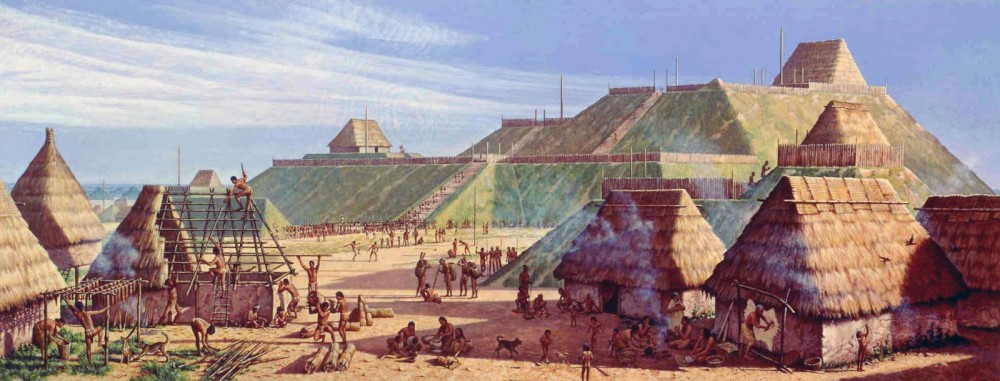 Cahokia, by Michael Hampshire. Cahokia Mounds State Historic Site.
Cahokia, by Michael Hampshire. Cahokia Mounds State Historic Site.
¶ 2 Leave a comment on paragraph 2 0 *Click here to view the current published draft of this chapter*
1. The First Americans
¶ 3 Leave a comment on paragraph 3 4 The last global ice age trapped much of the world’s water in enormous continental glaciers. Twenty thousand years ago, ice sheets, some a mile thick, extended across North America as far south as modern-day Illinois and Ohio. With so much of the world’s water captured in these massive ice sheets, global sea levels plummeted and the receding waters exposed a land bridge between Asia and North America across the Bering Strait. The first Americans most likely migrated from Asia sometime between twelve and twenty-thousand years ago, if not before. Nomadic hunter-gatherers, they traveled in small bands following megafauna–enormous mammals that included mastodons and giant horses and bison–into the frozen Beringian tundra at the edge of North America. Then, sometime between twelve- and fourteen-thousand years ago, the glaciers’ long retreat freed them to enter the heart of North America. Behind them the land bridge closed and severed the two hemispheres, but in North America, as the ice retreated, humans filled the continents and by 11,000 years ago migrating peoples had reached the tip of South America. Hunters across the hemisphere preyed on plentiful game and natural foods and the population boomed.
¶ 4 Leave a comment on paragraph 4 3 Whether because of overhunting, climate change, or a combination of the two, the megafauna population collapsed and mastodons, horses, and other large mammals disappeared. But native populations adapted: they fished, hunted small mammals, and gathered nuts and berries. Native peoples spread across North America. Woodland groups populated the Atlantic coast and later practiced agriculture to supplement rich hunting and fishing. On the plains, nomads followed bison herds. In the Northwest, natives exploited great salmon-filled rivers. And as paleo-Indians populated mountains, prairies, deserts, and forests, cultures and ways of life as arose as varied as the geography. Paleo-Indian groups spoke hundreds of languages and adopted distinct cultural practices. Woodland cultures burned underbrush to create vast park-like hunting grounds. Men typically hunted and women typically gathered and prepared wild foods. Rich and diverse diets fueled massive population growth across the continent.
¶ 5 Leave a comment on paragraph 5 1 Between two and eighteen million people lived north of present-day Mexico before the arrival of Europeans. They were not isolated among themselves, but connected by complex relationships and long trading routes. By 3,500 years ago, for instance, copper from present-day Canada and flint from modern-day Indiana could be found in Poverty Point, Louisiana.
¶ 6 Leave a comment on paragraph 6 2 Agriculture arose sometime between nine- and five-thousand years ago, almost simultaneously in the Eastern and Western Hemispheres. Mesoamericans in modern-day Mexico and Central America first domesticated maize and and developed perhaps the hemisphere’s first settled population around 1,200 BCE. The Olmecs grew maize (corn), built monumental stone structures, and established long-distance trade routes that extended across the region and eventually the hemisphere. Corn was high in caloric content, could be easily dried and stored, and, in Mesoamerica’s warm and fertile Gulf Coast, could sometimes be harvested twice in a year. Corn and other Mesoamerican crops made their way to the peoples of North America where it flourished especially in the fertile river valleys between the Mississippi River and Atlantic Ocean. There, three crops in particular–corn, beans, and squash, the so-called “Three Sisters”–provided nutritional needs necessary to sustain cities and civilizations.
¶ 7 Leave a comment on paragraph 7 3 Most North American native peoples lived in small communities tied by kinship networks. The majority followed matrilineal descent through the mother’s family, or clan. Typically, family ties followed the women of a family group so that when Native Americans married, it was the husband that joined the wife’s clan. This type of family organization led to a different family dynamic than we may be used to. When a child was born, the biological father was secondary in raising the child to the mother’s brother(s). Thus, what we consider as fathers functioned much like what we consider as uncles, and vice versa. It was the mothers, then, that were the glue holding the social fabric of most Native societies together and mothers who wielded enormous influence at the village level. Native mens’ identities were forged in their matrilineal clan, their village, and their skill as hunters and warriors. In this sense, male social prestige could be earned through masculine exploits, but were always tied to their mother’s clan. The most prestigious men were what Muskogee peoples dubbed the “Mico,” or to Algonquian peoples, “Sachem.” This leader led not through coercion, but instead influence. Muskogee peoples believed they had to seek balance through the universe between red and white. There were red and white clans, villages, and leaders. The red impulse was for war, while the white denoted peace. Micos often were older prestigious men in the community who attempted through their social influence to use diplomacy to keep the peace. Meanwhile, villages also had a red leader, who was the most influential warrior in the village. The tension between red and white meant that sometimes the Mico could not restrain the warriors. The village women also possessed great political clout. Such political arrangements meant that influence could be fleeting and was always contested.
¶ 8 Leave a comment on paragraph 8 0 Agriculture permeated North America over the centuries before contact with European invaders. The practices that have become to be known by scholars as the “corn, beans, and squash” complex practiced by many native peoples allowed for social change. Scholars debate over which came first, agriculture or larger Native American populations, but it is certain that the development of more hierarchical societies went hand in hand with the control over natural resource production allowed by agriculture. Several expansive civilizations in the Midwest and Southwest demonstrated the potential for large-scale Indian civilizations. The so-called Mississippians exploited the rich floodplains of the Mississippi River and built a network of settlements across the Midwest and the American South. Mississippian society was stratified. Elites maintained power through kinship, gift-giving, and by controlled access to the spiritual world. The Mississippian’s signature mounds–enormous earthworks that could span acres and climb several stories tall–physically set priests and elites above the general population of craftsmen, agricultural workers, and slaves.
¶ 9 Leave a comment on paragraph 9 0 The Mississippians developed the largest and most advanced native civilization north of modern-day Mexico. Roughly one-thousand years ago, the largest Mississippian settlement, Cahokia, located just east of modern-day St. Louis, peaked at a population of between 10,000-30,000. It rivaled contemporary European cities in size. (No American city, in fact, would match Cahokia’s peak population levels until after the American Revolution). Located near the confluence of the Mississippi, Illinois, and Missouri Rivers, Cahokia became a key trading center with networks stretching from the Great Lakes to the American Southeast. The city itself spanned 2,000 acres. Religious ceremonies were performed atop vast “mounds,” the enormous man-made earthen hills that still dot the Midwest and South. The largest mound at Cahokia, Monks Mound, rose ten-stories and was larger at its base than the great pyramids of Egypt. Scholars point to ecological collapse or mounting warfare as likely explanations for the Mississippians’ eventual collapse.
¶ 10
Leave a comment on paragraph 10 0
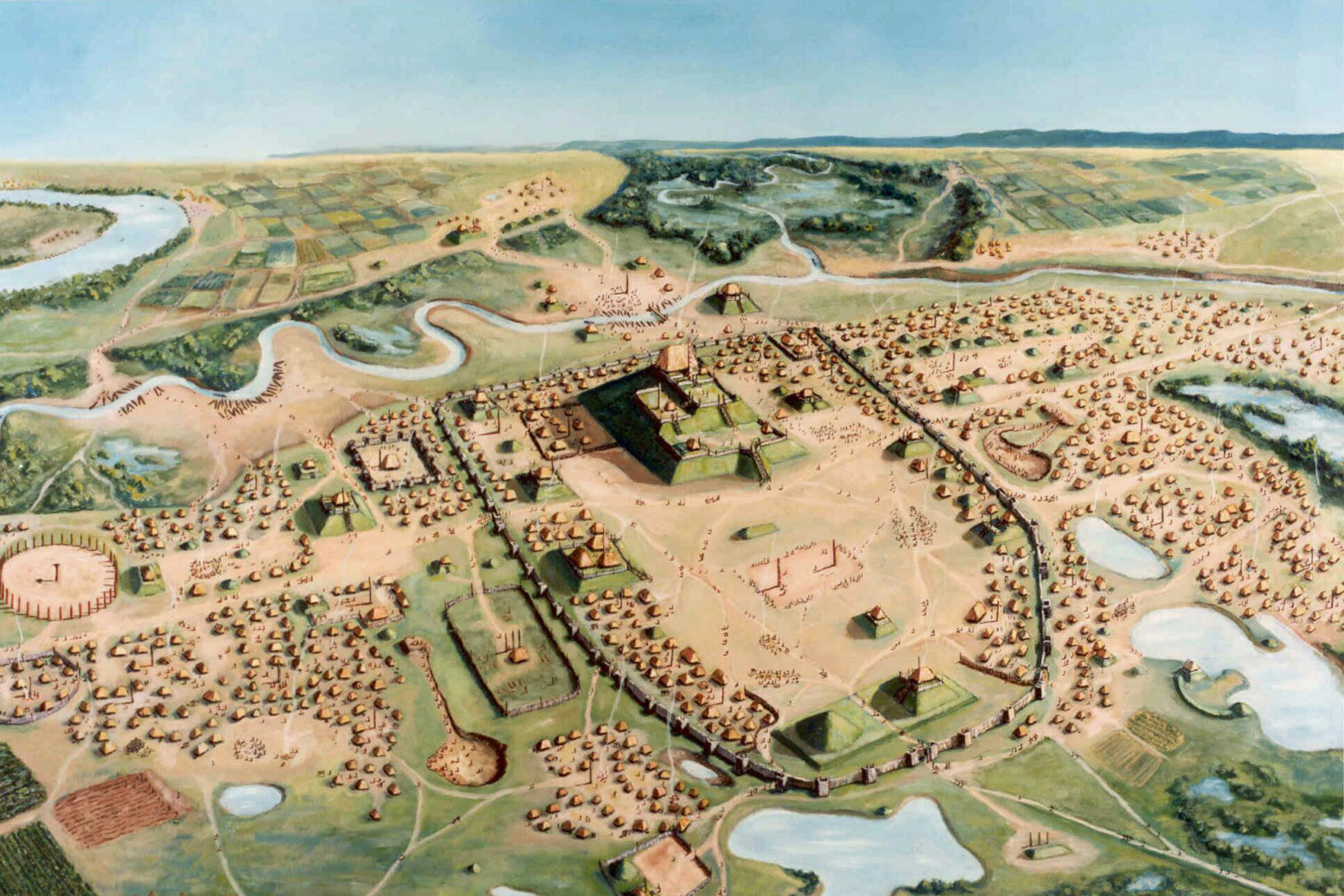 Cahokia, by Bill Iseminger. Cahokia Mounds State Historic Site
Cahokia, by Bill Iseminger. Cahokia Mounds State Historic Site
¶ 11 Leave a comment on paragraph 11 0 Meanwhile, in the American Southwest sometime between the years 900 and 1300 ancient Puebloan peoples built a large civilization sustained by advanced irrigation and a vast trading network linking goods from as far as Central Mexico and the Mississippi River. As many as 15,000 people lived in the Chaco Canyon complex in present-day New Mexico. One single building, Pueblo Bonito, rose five stories and contained over 600 rooms. (Not until the late-nineteenth century would another American building surpass it in sheer size.) It and other ancient adobe cliff dwellings persist as ruins. Decline–likely brought on by sustained droughts, overpopulation, and soil exhaustion–shattered the large Pueblo cities although Puebloan peoples persisted in New Mexico and would later resist the highpoint of Spain’s North American expansion.
¶ 12 Leave a comment on paragraph 12 1 In the Pacific Northwest, Indian peoples including the Kwaikiutis, Tlingits, and Haidas took advantage of the lush forests and many rivers. The abundance of large forest mammals including deerk, elk, moose, and caribou, as well as waters filled with salmon, halibut, sturgeon and others created a tremendous surplus of food. Massive ocean-sailing canoes, some over 50 feet in length, enabled extensive fishing expeditions. The food surplus enabled a unique social organization, where individuals achieved social status by giving elaborate feasts, called potlaches. These days-long parties allowed the host to demonstrate his wealth by feeding and entertaining guests with food and artwork. Elaborately carved totem poles, masks, and other wooden items carved out of the great trees of the region produced some of the world’s most unique art.
¶ 13
Leave a comment on paragraph 13 0
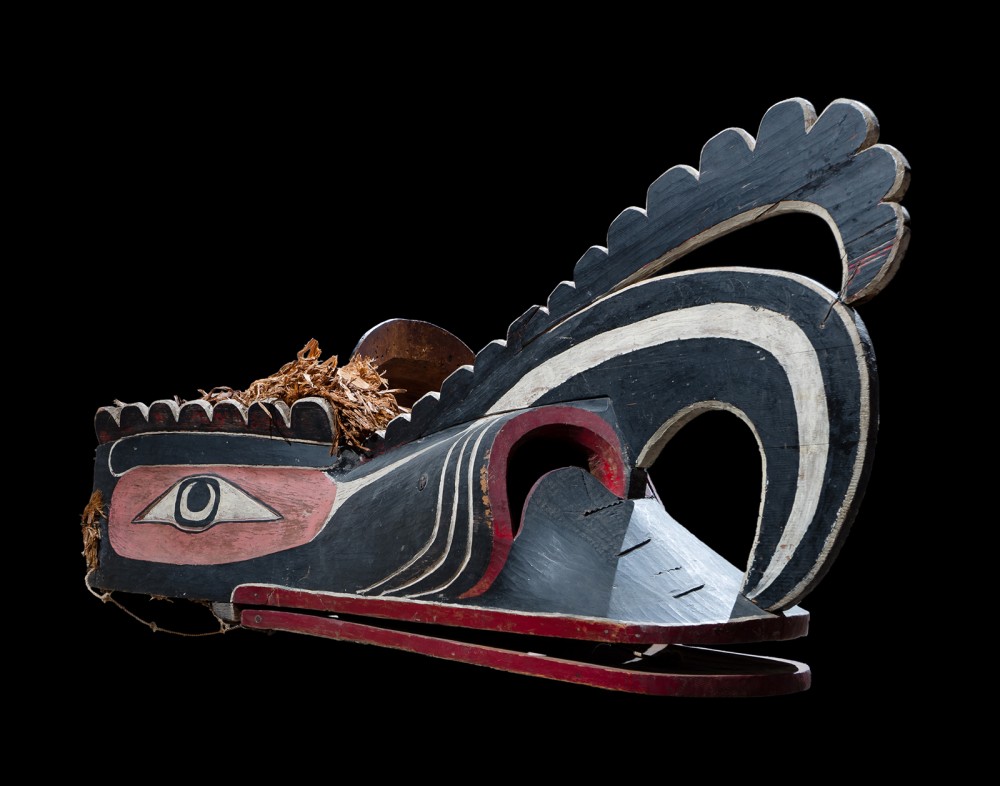 Intricately carved masks, like the Crooked Beak of Heaven Mask, used natural elements like animals to represent supernatural forces during ceremonial dances and festivals. 19th century brooked beak of heaven mask from the Kwakwaka’wakw (Pacific NW). Wikimedia, http://en.wikipedia.org/wiki/File:Crooked_Beak_of_Heaven_Mask.jpg.
Intricately carved masks, like the Crooked Beak of Heaven Mask, used natural elements like animals to represent supernatural forces during ceremonial dances and festivals. 19th century brooked beak of heaven mask from the Kwakwaka’wakw (Pacific NW). Wikimedia, http://en.wikipedia.org/wiki/File:Crooked_Beak_of_Heaven_Mask.jpg.
¶ 14 Leave a comment on paragraph 14 3 Despite their many differences, North America’s indigenous peoples shared some broad traits. Spiritual practices, beliefs on property, and kinship networks differed markedly from Europeans. Most Native Americans did not neatly distinguish between the natural and the supernatural. Spiritual power permeated their world and was both tangible and accessible. It could be appealed to and harnessed. Moreover, most native peoples’ notions of property rights differed markedly from Europeans. Native Americans generally felt a personal ownership of tools, weapons, or other items that were actively used. The same rule applied to land and crops. While groups and individuals exploited particular pieces of land, for instance, and through violence or negotiation would exclude others, the right to the use of land did not imply the right to permanent possession. Meanwhile, kinship bound most native North American people together. Native cultures understood ancestry as matrilineal—family and clan identity proceeded along the female line, through mothers and daughters, rather than fathers and sons. Native American culture meanwhile generally afforded greater sexual and marital freedom. Women often chose their husbands, and divorce often was a relatively simple and straightforward process.
¶ 15 Leave a comment on paragraph 15 1 Despite commonalities, native cultures varied greatly. From massive empires to scattered nomads, from agriculturalists to hunter-gatherers, the New World was marked by diversity and contrast. By the time Europeans were poised to cross the Atlantic, Native Americans spoke hundreds of languages and had adapted their lives to the hemisphere’s many climates. Some lived in cities, others in small bands. Some migrated seasonally, others settled permanently. Native peoples had long histories and well-formed unique cultures that developed and evolved over millennia. But the arrival of Europeans changed everything.
¶ 16 Leave a comment on paragraph 16 0
2. European Expansion
¶ 17 Leave a comment on paragraph 17 1 Scandinavian seafarers reached the New World centuries before Columbus. At their peak they sailed as far east as Constantinople and raided settlements as far south as North Africa. They established limited colonies in Iceland and Greenland and, around the year 1000, Leif Erikson reached New Foundland in present-day Canada. But the Norse colony failed. Culturally and geographically isolated, some combination of limited resources, inhospitable weather, food shortages, and native resistance drove the Norse back into the sea.
¶ 18 Leave a comment on paragraph 18 1 Hundreds of years before Columbus, the Crusades linked Europe with the wealth, power, and knowledge of Asia. Europeans rediscovered or adopted Greek, Roman, and Muslim knowledge. The hemispheric dissemination of goods and knowledge not only sparked the Renaissance but fueled long-term European expansion. Asian goods flooded European markets, creating a demand for new commodities. This trade created vast new wealth, and Europeans battled one another for trade supremacy.
¶ 19 Leave a comment on paragraph 19 0 European nation-states consolidated under the authority of powerful kings. A series of military conflicts between England and France–the Hundred Years War–accelerated nationalism and cultivated the financial and military administration necessary to maintain nation-states. In Spain, the marriage of Ferdinand of Aragon and Isabella of Castille consolidated the two most powerful kingdoms of the Iberian peninsula. The Crusades had never ended in Iberia: the Spanish crown concluded centuries’ of intermittent warfare–the Reconquista–by expelling Muslim Moors from the Iberian peninsula in 1492, just as Columbus sailed west. With new power, these new nations–and their newly empowered monarchs–yearned to access the wealth of Asia.
¶ 20 Leave a comment on paragraph 20 2 Seafaring Italian traders commanded the Mediterranean and controlled trade with Asia. Spain and Portugal, at the edges of Europe, relied upon middlemen and paid higher prices for Asian goods. They sought a more direct route. And so they looked to the Atlantic. Portugal invested heavily in exploration. From his estate on the Sagres Peninsula of Portugal, a rich sailing port, Prince Henry the Navigator (Infante Henry, Duke of Viseu) invested in research and technology and underwrote many technological breakthroughs. His investments bore fruit. In the fifteenth century Portuguese sailors innovated the astrolabe, a tool to calculate latitude, and the caravel, a ship well-suited for ocean exploration. Both were technological breakthroughs. The astrolabe allowed for precise navigation and the caravel, unlike more common vessels designed for trading on the relatively placid Mediterranean, was a rugged, deep-drafting ship capable of making lengthy voyages on the open ocean and, equally important, carrying large amounts of cargo while doing so.
¶ 21 Leave a comment on paragraph 21 0 Blending economic and religious motivations, the Portuguese established forts along the Atlantic coast of Africa during the fifteenth century, inaugurating centuries of European colonization there. Portuguese trading posts generated new profits that funded further trade and further colonization. Trading posts spread across the vast coastline of Africa and by the end of the fifteenth century Vasco de Gama leapfrogged his way around the coasts of Africa to reach India and lucrative Asian markets.
¶ 22 Leave a comment on paragraph 22 0 The vagaries of ocean currents and the limits of contemporary technology forced Iberian sailors to sail west into the open sea before cutting back east to Africa. So doing, the Spanish and Portuguese stumbled upon several islands off the coast of Europe and Africa, including the Azores, the Canary Islands, and the Cape Verde Islands. They became training ground for the later colonization of the Americas.
¶ 23 Leave a comment on paragraph 23 0 Sugar, a wildly profitable commodity originally grown in Asia, had become a popular luxury among the nobility and wealthy of Europe. The Portuguese began growing sugar cane along the Mediterranean, but sugar was a difficult crop. It required tropical temperatures, daily rainfall, unique soil conditions, and a fourteen-month growing season. But with the Atlantic Islands, the Portuguese had found new land to support sugar production and new patterns of human and ecological destruction followed. Isolated from the mainlands of Europe and Africa for millennia, island natives—known as the Guanches—were enslaved or perished soon after Europeans arrived. Portugal’s would-be planters needed laborers to cultivate the difficult, labor-intensive crop. Portuguese merchants, who had recently established good relations with powerful African kingdoms such as Kongo, Ndongo, and Songhai, looked to African slaves. Slavery had long existed among African societies. African leaders traded war captives—who by custom forfeited their freedom in battle—for Portuguese guns, iron, and manufactured goods. From bases along the Atlantic coast, the largest in modern-day Nigeria, the Portuguese began purchasing slaves for export to the Atlantic islands. Slaves would work the sugar fields. Thus were born the first great Atlantic plantations.
¶ 24
Leave a comment on paragraph 24 0
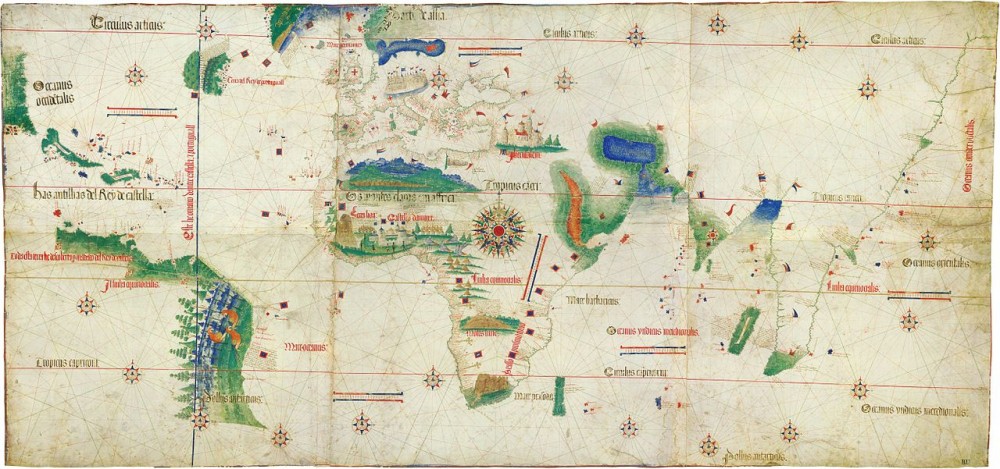 By the fifteenth century, the Portuguese had established forts and colonies on islands and along the rim of the Atlantic Ocean; other major Europeans countries soon followed in step. An anonymous cartographer created this map known as the Cantino Map, the earliest known map of European exploration in the New World, to depict these holdings and argue for the greatness of his native Portugal. “Cantino planisphere” (1502), Biblioteca Estense, Modena, Italy. Wikimedia, http://commons.wikimedia.org/wiki/File:Cantino_planisphere_%281502%29.jpg.
By the fifteenth century, the Portuguese had established forts and colonies on islands and along the rim of the Atlantic Ocean; other major Europeans countries soon followed in step. An anonymous cartographer created this map known as the Cantino Map, the earliest known map of European exploration in the New World, to depict these holdings and argue for the greatness of his native Portugal. “Cantino planisphere” (1502), Biblioteca Estense, Modena, Italy. Wikimedia, http://commons.wikimedia.org/wiki/File:Cantino_planisphere_%281502%29.jpg.
¶ 25 Leave a comment on paragraph 25 0 Spain, too, stood on the cutting edge of maritime technology. Spanish sailors had become masters of the caravels. And as Portugal consolidated control over its African trading networks along the circuitous eastbound sea route to Asia, Spain yearned for its own path to empire. Christopher Columbus, a skilled Italian-born sailor who studied under Portuguese navigators, came calling.
¶ 26 Leave a comment on paragraph 26 1 Educated Asians and Europeans of the fifteenth century knew the world was round. They also knew that while it was therefore technically possible to reach Asia by sailing west from Europe–thereby avoiding Italian or Portuguese middlemen–the Earth’s vast size would doom even the greatest caravels to starvation and thirst long before they ever reached their destination. But Columbus underestimated the size of the globe by a full two-thirds and therefore believed it was possible. After unsuccessfully shopping his proposed expedition in several European courts, he convinced Queen Isabella and King Ferdinand of Spain to provide him three small ships, which set sail in 1492. Columbus was both confoundingly wrong about the size of the Earth and spectacularly lucky that two large continents lurked in his path. On October 12, 149, after two months at sea, the Nina, Pinta, and Santa Maria and their ninety men landed in the modern-day Bahamas.
¶ 27 Leave a comment on paragraph 27 0 The indigenous Arawaks populated the Caribbean islands. They fished and grew corn, yams, and cassava. Columbus described them as innocents. “They are very gentle and without knowledge of what is evil; nor do they murder or steal,” he reported to the Spanish crown. “Your highness may believe that in all the world there can be no better people … They love their neighbours as themselves, and they have the sweetest talk in the world, and are gentle and always laughing.” But Columbus had come for wealth and he could find little. The Arawaks, however, wore small gold ornaments. Columbus left thirty-nine Spaniards at a military fort to find and secure the source of the gold while he returned to Spain to great acclaim and to outfit a return voyage.
¶ 28 Leave a comment on paragraph 28 0 Spain’s New World motives were clear from the beginning. If outfitted for a return voyage, Columbus promised the Spanish crown “as much gold as they need” and “as many slaves as they ask.” “They would make fine servants,” Columbus reported, referring to the indigenous Caribbeans. “With fifty men we could subjugate them all and make them do whatever we want.” It was God’s will, he said.
¶ 29 Leave a comment on paragraph 29 1 Columbus was outfitted with seventeen ships and over 1,000 men to return to the West Indies (Columbus made four total voyages to the New World). Still believing he had landed in the East Indies, he promised to reward Isabella and Ferdinand’s investment. But when material wealth proved slow in coming the Spanish embarked upon a vicious campaign to extract every possible ounce of wealth from the Caribbean. The Spanish decimated the Arawaks. Bartolome de Las Casas traveled to the New World ten years after Columbus. He would later write that “My eyes have seen these acts so foreign to human nature, and now I tremble as I write.” Las Casas said the Indians were peaceful, but “our work was to exasperate, ravage, kill, mangle and destroy.” He said, “they suffered and died in the mines and other labors in desperate silence, knowing not a soul in the world to whom they could turn for help.” When the enslaved Indians exhausted the island’s meager gold reserves, the Spaniards forced them to labor on on their huge new estates, the encomiendas. Las Casas described European barbarities in cruel detail. By presuming the natives had no humanity, the Spaniards utterly abandoned theirs. Casual violence and dehumanizing exploitation ravaged the Arawaks. “The admiral, it is true,” Las Casas said, referring to Columbus, “was blind as those who came after him, and he was so anxious to please the King that he committed irreparable crimes against the Indians….” The Indian population collapsed. Within a few generations a whole island had been depopulated and a whole people exterminated. Historians’ estimates range from fewer than 1 million to as many as 8 million (Las Casas estimated the pre-contact population of the island at 3 million). In a few short years, they were gone. “Who in future generations will believe this?” Las Casas wondered. “I myself writing it as a knowledgeable eyewitness can hardly believe it.”
¶ 30 Leave a comment on paragraph 30 1 Despite the diversity of native populations and the existence of several strong empires, native Americans were wholly unprepared for the arrival of Europeans and biology magnified European cruelties many times over. Cut off from the Old World and it’s domesticated animals and its immunological history, Native Americans lived free from the terrible diseases that ravaged populations in Asia, Europe and Africa. But their blessing now became a curse. Native Americans lacked the immunities that Europeans and Africans had developed over centuries of deadly epidemics and so when Europeans arrived, carrying smallpox, typhus, influenza, diphtheria, measles, and hepatitis, plagues decimated native communities. Many died in war and slavery, but millions died in epidemics. All told, in fact, some scholars estimate that as much as 90 percent of the population of the Americas perished within the first century and a half of European contact.
¶ 31 Leave a comment on paragraph 31 1 Though ravaged by disease and warfare, Native Americans forged middle grounds, resisted with violence, accommodated and adapted to the challenges of colonialism, and continued to shape the patterns of life throughout the New World for hundreds of years. But the Europeans kept coming.
¶ 32 Leave a comment on paragraph 32 0
3. Spanish Exploration and Conquest
¶ 33 Leave a comment on paragraph 33 0 As news of the Spanish conquest spread, wealth-hungry Spaniards poured into the New World seeking land and gold and titles. A New World empire spread from Spain’s Caribbean foothold. Motives were plain: said one soldier, “we came here to serve God and the king, and also to get rich.” Mercenaries joined the conquest and raced to capture the human and material wealth of the New World.
¶ 34 Leave a comment on paragraph 34 0 The Spanish managed labor relations through a legal system known as the encomienda, an exploitive feudal arrangement in which Spain tied Indian laborers to vast estates. In the encomienda, the Spanish crown granted a person not only land but a specified number of natives as well. Encomenderos brutalized their laborers with punishing labor. After Bartolome de Las Casas published his incendiary account of Spanish abuses (The Destruction of the Indies), Spanish authorities abolished the encomienda in 1542 and replaced it with the repartimiento. Intended as a milder system, the repartimiento nevertheless replicated many of the abuses of the older system and the rapacious exploitation of the native population continued as Spain spread its empire over the Americas.
¶ 35
Leave a comment on paragraph 35 0
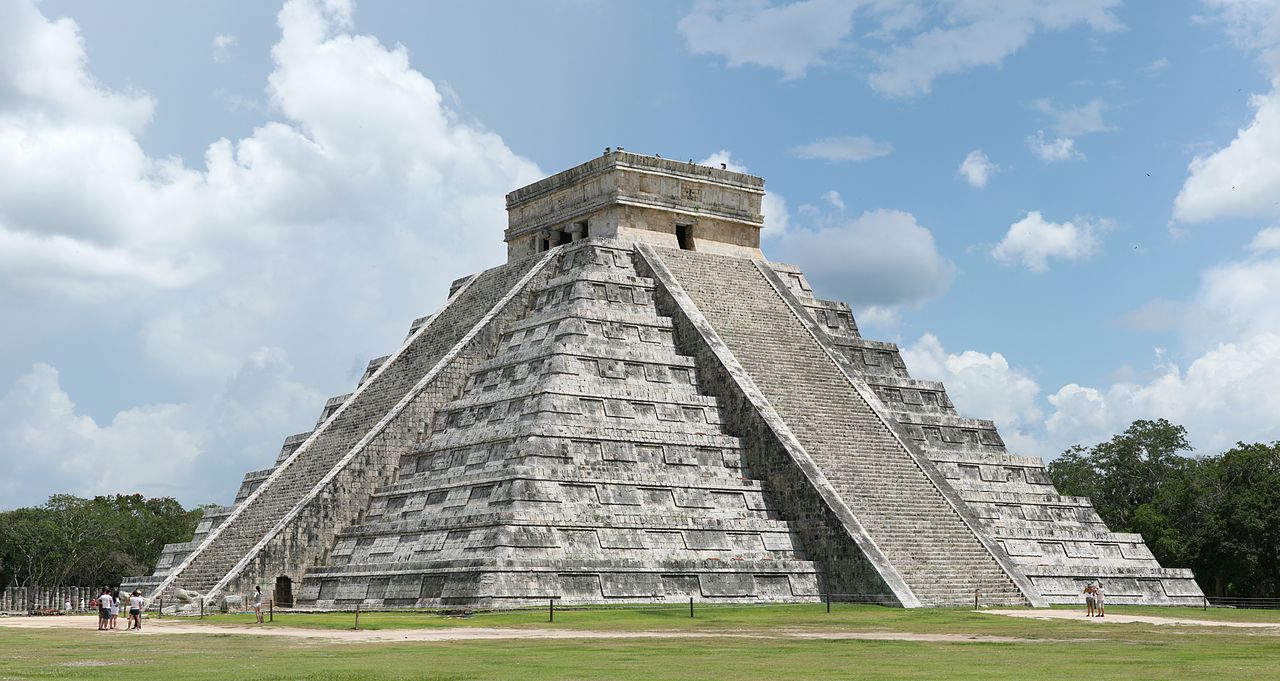 El Castillo (pyramidd of Kukulcán) in Chichén Itzá, photograph by Daniel Schwen, via Wikimedia Commons
El Castillo (pyramidd of Kukulcán) in Chichén Itzá, photograph by Daniel Schwen, via Wikimedia Commons
¶ 36 Leave a comment on paragraph 36 0 As Spain’s New World empire expanded, Spanish conquerors met the massive empires of Central and South America, civilizations that dwarfed anything found in North America. In central America the Maya built massive temples, sustained large populations, and constructed a complex and long-lasting civilization with a written language, advanced mathematics, and stunningly accurate calendars. But Maya civilization, although it had not disappeared, nevertheless collapsed before European arrival, likely due to droughts and unsustainable agricultural practices. But the eclipse of the Maya only heralded the later rise of the most powerful native civilization ever seen in the Western Hemisphere: the Aztecs.
¶ 37 Leave a comment on paragraph 37 0 Militaristic migrants from northern Mexico, the Aztecs moved south into the Valley of Mexico, conquered their way to dominance, and built the largest empire in the New World. When the Spaniards arrived in Mexico they found a sprawling civilization centered around Tenochtitlan, an awe-inspiring city built on a series of natural and man-made islands in the middle of Lake Texcoco, located today within modern-day Mexico City. Tenochtitlan, founded in 1325, rivaled the world’s largest cities in size and grandeur. Much of the city was built on large artificial islands called chinampas which the Aztecs constructed by dredging mud and rich sediment from the bottom of the lake and depositing it over time to form new landscapes. A massive pyramid temple, the Templo Mayor, was located at the city center (its ruins can still be found in the center of Mexico City). When the Spaniards arrived they could scarcely believe what they saw: 70,000 buildings, housing perhaps 200,000-250,000 people, all built on a lake and connected by causeways and canals. Bernal Díaz del Castillo, one of Cortez’s soldiers, later recalled, “When we saw so many cities and villages built in the water and other great towns on dry land, we were amazed and said that it was like the enchantments … Some of our soldiers even asked whether the things that we saw were not a dream? … I do not know how to describe it, seeing things as we did that had never been heard of or seen before, not even dreamed about.”
¶ 38 Leave a comment on paragraph 38 2 From their island city the Aztecs dominated an enormous swath of central and southern Mesoamerica. They ruled their empire not through a decentralized network of subject peoples that paid regular tribute–including everything from the most basic items, such as corn, beans, and other foodstuffs, to luxury goods such as jade, cacao, and gold–and provided troops for the empire. But unrest festered beneath the Aztec’s imperial power and European conquerors lusted after its vast wealth.
¶ 39
Leave a comment on paragraph 39 0
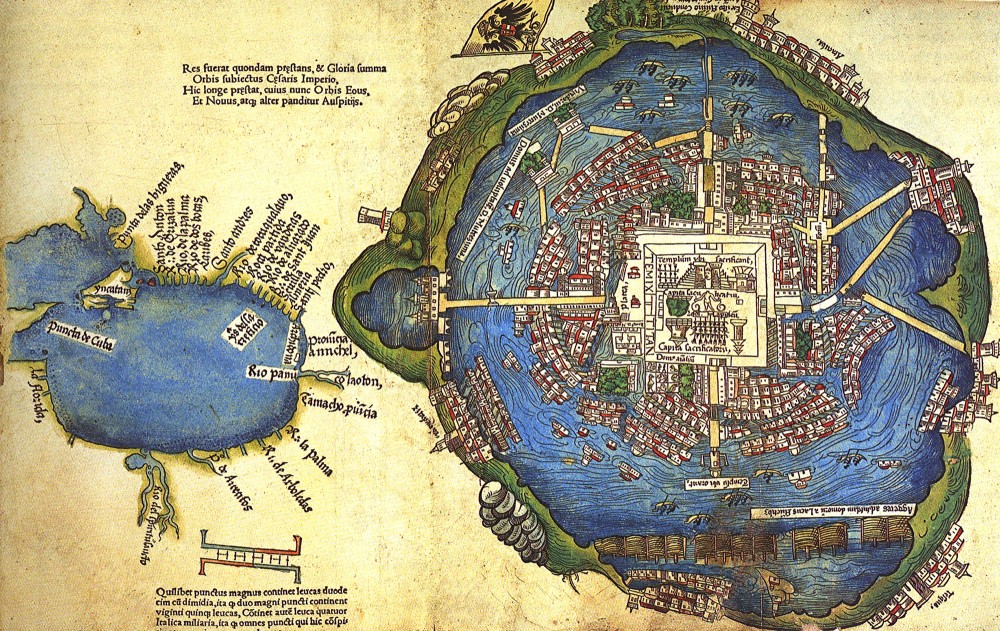 This sixteenth-century map of Tenochtitlan shows the aesthetic beauty and advanced infrastructure of this great Aztec city. Map, c. 1524, Wikimedia.
This sixteenth-century map of Tenochtitlan shows the aesthetic beauty and advanced infrastructure of this great Aztec city. Map, c. 1524, Wikimedia.
¶ 40 Leave a comment on paragraph 40 0 Hernan Cortes, an ambitious, thirty-four year old Spaniard who had won riches in the conquest of Cuba, organized an invasion of Mexico in 1519. Sailing with 600 men, horses, and cannon, he landed on the coast of Mexico. Relying on a native translator, whom he called Doña Marina, and whom Mexican folklore denounces as La Malinche, Cortes gathered information and allies in preparation for conquest. Through intrigue, brutality, and the exploitation of endemic political divisions, he enlisted the aid of thousands of native allies, defeated Spanish rivals, and marched on Tenochtitlan.
¶ 41 Leave a comment on paragraph 41 0 Aztec dominance rested upon fragile foundations and many of the region’s semi-independent city-states yearned to break from Aztec rule while nearby kingdoms, including Tarascans to the north, and the remains of Maya city-states on the Yucatán peninsula, chafed at Aztec power.
¶ 42 Leave a comment on paragraph 42 0 Through persuasion, and maybe because some Aztecs thought Cortes was the god Quetzalcoatl, the Spaniards entered Tenochtitlán peacefully. Cortes then captured the emperor Montezuma and used him to gain control of the Aztecs’ gold and silver reserves and its network of mines. Eventually, the Aztecs revolted. Montezuma was branded a traitor and uprising ignited the city. Montezuma was killed along with a third of Cortes’s men in la noche triste, the “night of sorrows.” The Spanish fought through thousands of indigenous insurgents and across canals to flee the city, where they regrouped, enlisted more native allies, captured Spanish reinforcements, and, in 1521, besieged the island city. The Spaniard’s eighty-five day siege cut off food and fresh water. Smallpox ravaged the city. One Spanish observer said it “spread over the people as great destruction. Some it covered on all parts—their faces, their heads, their breasts, and so on. There was great havoc. Very many died of it … They could not move; they could not stir.” Cortes, the Spaniards, and their native allies then sacked the city. 15,000 died. The temples were unmade. After two years of conflict, a million-person strong empire was toppled by disease, dissension, and a thousand European conquerors.
¶ 43
Leave a comment on paragraph 43 0
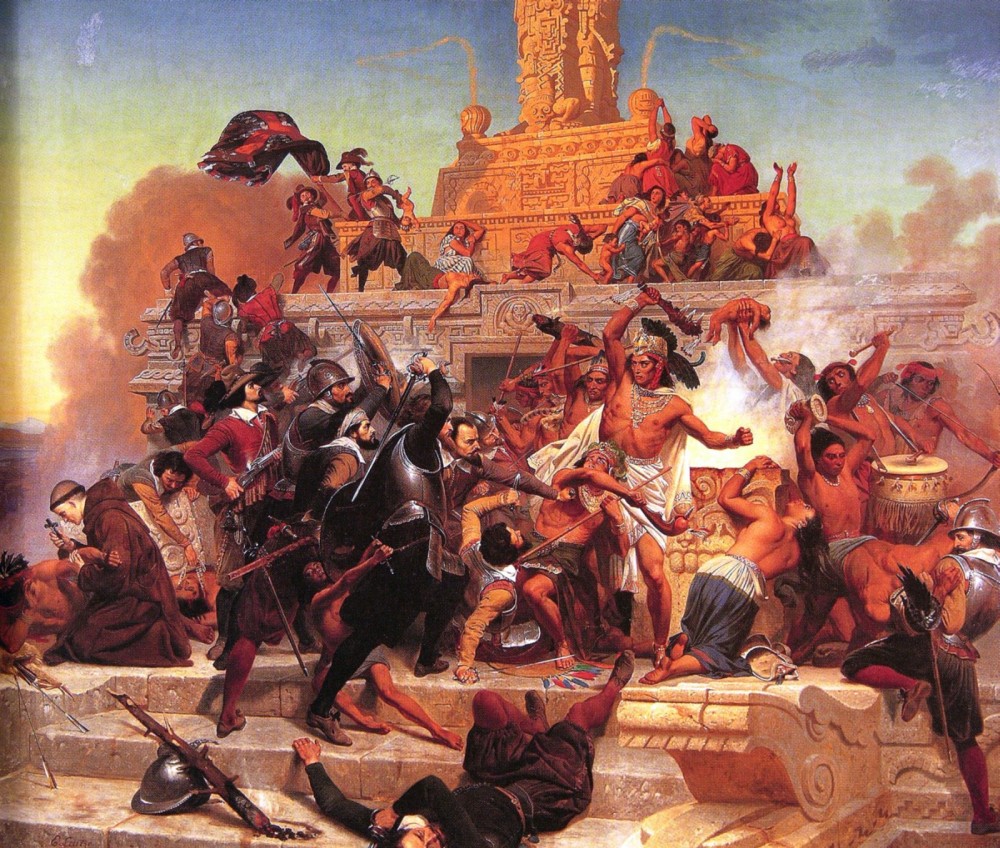 Emanuel Gottlieb Leutze, “Storming of the Teocalli by Cortez and His Troops,” 1848. Wikimedia.
Emanuel Gottlieb Leutze, “Storming of the Teocalli by Cortez and His Troops,” 1848. Wikimedia.
¶ 44 Leave a comment on paragraph 44 0 Further south, along the Andes Mountains in South America, the Quechuas, or Incas, managed a vast mountain empire. From their capital of Cuzco in the Andean highlands, through conquest and negotiation, the Inca built an empire that stretched around the western half of the South American continent from present day Ecuador to central Chile and Argentina. They built steppes to farm fertile mountain soil and by the 1400s they managed a thousand miles of Andean roads that tied together perhaps twelve million people. But like the Aztecs, unrest between the Incas and conquered groups created tensions and left the empire vulnerable to foreigners. Smallpox spread in advance of Spanish conquerors and hit the Incan empire in 1525. Epidemics ravaged the population, cutting the empire’s population in half, killing the Incan emperor Huayna Capac and many members of his family and sparking a bloody war of succession. Inspired by Cortes’s conquest of Mexico, Francisco Pizzaro moved South and arrived amid an empire torn by chaos. With 168 men, he deceived Incan rulers and took control of the empire and seized the capital city, Cuzco, in 1533. Disease, conquest, and slavery ravaged the remnants of the Incan empire.
¶ 45 Leave a comment on paragraph 45 0 After the conquests of Mexico and Peru, Spain settled into empire. A vast administrative hierarchy governed its new holdings: royal appointees oversaw an enormous territory of landed estates and Indian laborers and administrators regulated the extraction of gold and silver and oversaw their transport across the Atlantic in Spanish galleons. Meanwhile Spanish migrants poured into the New World. 225,000 migrated during the sixteenth century alone, and 750,000 came during the entire three centuries of Spanish colonial rule. Spaniards, often single, young, and male, emigrated for the various promises of land, wealth, and social advancement. Laborers, craftsmen, soldiers, clerks, and priests all crossed the Atlantic in large numbers. Indians, however, always outnumbered the Spanish and the Spaniards, by both necessity and design, incorporated native Americans–unequally–into colonial life.
¶ 46 Leave a comment on paragraph 46 0 An elaborate racial hierarchy marked Spanish life in the New World. Regularized in the mid-1600s but rooted in medieval practices, the Sistema de Castas organized individuals into various racial groups based upon their supposed “purity of blood.” Various classifications—often elaborately arrived at—became almost prerequisites for social and political advancement in Spanish colonial society. Peninsulares—Iberian-born Spaniards, or Españoles–occupied the highest levels of administration and acquired the greatest estates. Their descendants, New World-born Spaniards, or criollos, occupied the next rung and rivaled the peninsulares for wealth and opportunity. Mestizos–a term used to describe those of mixed Spanish and Indian heritage–followed.
¶ 47 Leave a comment on paragraph 47 0 Like the French later in North America, the Spanish tolerated and often supported interracial marriage. There were simply too few Spanish women in the New World to support the natural growth of a purely Spanish population. The Catholic Church endorsed interracial marriage as a moral bulwark against bastardy and rape. As early as 1533, King Carlos I declared that any child with Spanish blood “to the half” was entitled to certain Spanish rights. By 1600, mestizos made up a large portion of the colonial population. By the early 1700s, more than one-third of all marriages bridged the Spanish-Indian divide. Largely separated by wealth and influence from the peninsulares and criollos, however, mestizos typically occupied a middling social position in Spanish New World society. They were not quite Indios, or Indians, but their lack of limpieza de sangre, or “pure blood,” removed them from the privileges of full-blooded Spaniards. Spanish fathers of sufficient wealth and influence might shield their mestizo children from racial prejudice, and a number of wealthy mestizos married Españoles to “whiten” their family lines, but more often mestizos were confined to a middle-station in the Spanish New World.
¶ 48 Leave a comment on paragraph 48 0 Slaves and Indians occupied the lowest rungs of the social ladder. After Bartolome de las Casas and other reformers shamed the Spanish for their harsh Indian policies in the 1530s, the Spanish outlawed Indian slavery. In the 1550s, the encomienda system of land-based forced-labor gave way to the repartimiento, an exploitative but slightly softer form of forced wage-labor. Slaves labored especially on Spain’s Caribbean plantation islands.
¶ 49 Leave a comment on paragraph 49 0 Many manipulated the Casta System to gain advantages for themselves and their children. Mestizo mothers, for instance, might insist that their mestizo daughters were actually castizas, or quarter-Indians, who, if they married a Spaniard, could, in the eyes of the law, produce “pure” criollo children entitled to the full rights and opportunities of Spanish citizens. But “passing” was an option for the few. Instead, the massive native populations within Spain’s New World Empire ensured a level of cultural and racial mixture–or Mestizaje–unparalleled in British North America. Spanish North America wrought a hybrid culture that was neither fully Spanish nor fully Indian. The Spanish not only built Mexico City atop Tenochtitlán, but food, language, and families spilled across racial barriers. In 1531, a poor Indian named Juan Diego reported that he was visited by the Virgin Mary, who came as a dark-skinned Nahuatl-speaking Indian. Reports of miracles spread across Mexico and the Virgen de Guadalupe became a national icon for a new mestizo society.
¶ 50
Leave a comment on paragraph 50 0
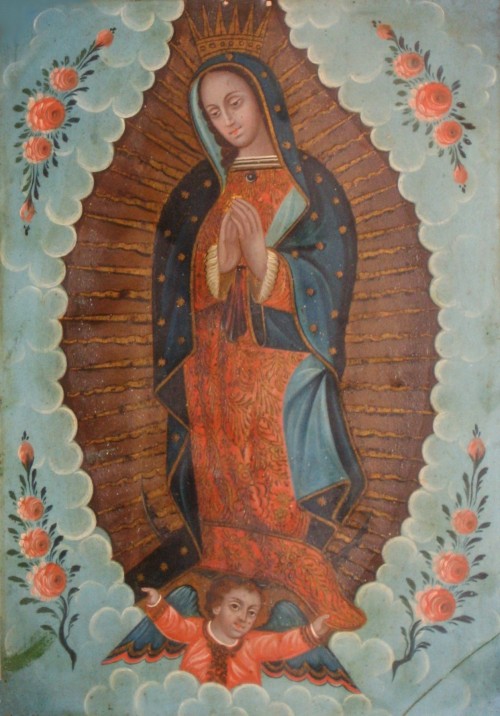 Our Lady of Guadalupe is perhaps the most culturally important and extensively reproduced Mexican-Catholic image. In the iconic depiction, Mary stands atop the tilma (peasant cloak) of Juan Diego, on which according to his story appeared the image of the Virgin of Guadalupe. Throughout Mexican history, the story and image of Our Lady of Guadalupe has been a unifying national symbol. Mexican retablo of “Our Lady of Guadalupe,” 19th century, in El Paso Museum of Art. Wikimedia.
Our Lady of Guadalupe is perhaps the most culturally important and extensively reproduced Mexican-Catholic image. In the iconic depiction, Mary stands atop the tilma (peasant cloak) of Juan Diego, on which according to his story appeared the image of the Virgin of Guadalupe. Throughout Mexican history, the story and image of Our Lady of Guadalupe has been a unifying national symbol. Mexican retablo of “Our Lady of Guadalupe,” 19th century, in El Paso Museum of Art. Wikimedia.
¶ 51 Leave a comment on paragraph 51 0 From Mexico Spain expanded northward. Lured by the promises of gold and another Tenochtitlán, Spanish expeditions scoured North America for another wealthy Indian empire. Huge expeditions, resembling vast moving communities, composed of hundreds of soldiers, settlers, priests, and slaves, with enormous numbers of livestock, moved across the continent. Juan Ponce de Leon, the conqueror of Puerto Rico, landed in Florida in 1513 in search of wealth and slaves. Cabeza de Vaca joined the Narvaez expedition to Florida a decade later, was shipwrecked, and embarked upon a remarkable multi-year odyssey across the Gulf of Mexico and the Texas continent into Mexico. Pedro Menéndez de Avilés founded St. Augustine, Florida, in 1565, and it remains the oldest, continuously occupied European settlement in the present-day United States.
¶ 52 Leave a comment on paragraph 52 1 But without the rich gold and silver mines of Mexico, the plantation-friendly climate of the Caribbean, or the exploitive potential of large Indian empires, North America offered little incentive for Spanish officials. Still, Spanish expeditions combed North America. Francisco Vazquez de Coronado pillaged his way across the Southwest. Hernando De Soto tortured and raped and enslaved his way across the Southeast.
¶ 53 Leave a comment on paragraph 53 0
4. The Columbian Exchange
¶ 54 Leave a comment on paragraph 54 2 The “discovery” of America unleashed horrors. Europeans embarked upon a debauching path of death and destructive exploitation that unleashed murder and greed and slavery. But disease was deadlier than any weapon in the European arsenal. It unleashed death on a scale never before seen in human history. Estimates of the population of pre-Columbian America range wildly. Some argue for as much as 100 million, some as low as 2 million. In 1983, Henry Dobyns put the number at 18 million. Whatever the precise estimates, nearly all scholars tell of the utter devastation wrought by European disease. Dobyns estimated that in the first 130 years following European contact, 95 percent of Native Americans perished. (At its worst, Europe’s Black Death peaked at death rates of 25% to 33%. Nothing else in history rivals the American demographic disaster.) A 10,000 year history of disease crashed upon the New World in an instant. Smallpox, typhus, the bubonic plague, influenza, mumps, measles: pandemics ravaged populations up and down the continents. Wave after wave of disease crashed relentlessly. Disease flung whole communities into chaos. Others it destroyed completely.
¶ 55 Leave a comment on paragraph 55 2 Disease was only the most terrible in a cross-hemispheric exchange of violence, culture, trade, and peoples–the so-called “Columbian Exchange”–that followed in Columbus’s wake. Global diets, for instance, were transformed. The America’s calorie-rich crops revolutionized Old World agriculture and spawned a worldwide population boom. Many modern associations between food and geography are but products of the Columbian Exchange: potatoes in Ireland, tomatoes in Italy, chocolate in Switzerland, peppers in Thailand, and citrus in Florida are all manifestations of the new global exchange. Europeans, for their part, introduced their domesticated animals to the New World. Pigs ran rampant through the Americas, transforming the landscape as the spread throughout both continents. Horses spread as well, transforming the Native American cultures who adapted to the newly introduced animal. Partly from trade, partly from the remnants of failed European expeditions, and partly from theft, Indians acquired horses and transformed native American life in the vast North American plains.
¶ 56 Leave a comment on paragraph 56 0 The European’s arrival bridged two worlds and ten-thousand years of history separated from each other since the closing of the Bering Strait. Both sides of the world had been transformed. And neither would ever again be the same.
I think this section should probably include at least some mention of the current Pre-Clovis theories. My impression as a non-specialist is that the Bering Strait theory of Native American origins, if not dead, mortally wounded.
Subsections should be numbered with Roman, not Arabic, numerals to stay consistent with subsequent chapters.